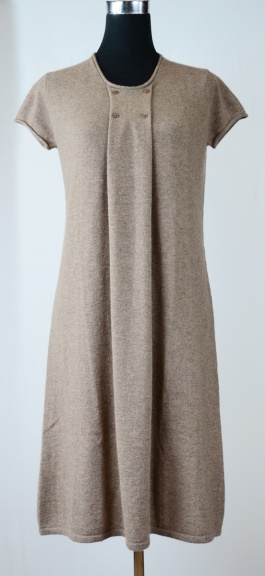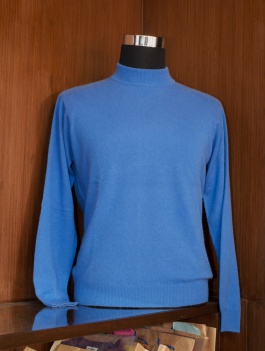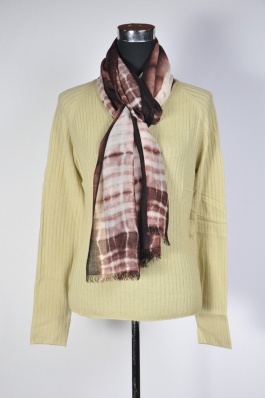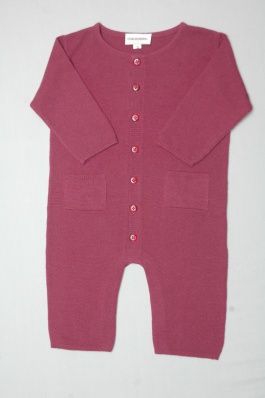Knitting is a method by which thread or yarn may be turned into cloth or other fine crafts. Knitted fabric consists of consecutive loops, called stitches. As each row progresses, a new loop is pulled through an existing loop. The active stitches are held on a needle until another loop can be passed through them. This process eventually results in a final product, often a garment.
There are two ways of knitting a sweater. A lot of the manufacturing companies used dyed cashmere yarn to knit. However, we dye the yarn ourselves so that there is always consistency in the color of our product as we have formulated our own colors. The process of knitting a scarf is fairly simple than knitting a sweater. Thus, we will walk you through the process of creating a sweater so that you can understand the entire process involved in knitting. The process of knitting is as painstaking as weaving and requires a lot patience and talent. Even though there are a series of process involved it is categorized into six parts
Wool Collection: Cashmere wool is a fiber obtained from cashmere goats. Common usage defines the fiber as a wool but in fact it is a hair, and this is what gives it its unique characteristics as compared to sheep's wool. Cashmere fiber is collected during the spring season when the goats naturally shed their winter coat. The fiber is then de-haired by a mechanical process that separates the coarse hairs from the fine hair.
Spinning: The finished fiber is then spun by hand into yarn. However, hand-spinning is an extremely painstaking task. It requires immense patience and dedication. With the advancement in technology, the spinning process is now done by machine and as a result the cashmere yarn is much finer and uniform.
Knitting: Knitting is done by knitting machines that are manually operated. First, all parts of the sweater like the sleeves, front side, back side and the neck pieces are knitted separately. These pieces are roughly linked together by sewing and without the use of linking machine because the pieces will be linked using the linking machine after they are dyed.
Washing: Washing is a crucial stage and is performed with great care in formulated soap in soft water at temperatures that are carefully controlled. The soap has a scouring agent in it which acts as a detergent; chemically removing oil that is in the yarn. On first rinsing, the oil is removed along with the loose dye and any loose fibre in the wash. Secondly, fresh warm water and soap are used to start milling the cashmere pieces to get them rubbing together; by doing this, tightly twisted fibres in the yarn begin to open up and expand, which once carefully dried, allows the cashmere piece to have the gorgeous feel, or ‘handle’ that is craved. However, it is very easy to overmill cashmere, which will in turn make it appear matted and felted. Once this has occurred there is no recovery process for this, and the pieces will need to be scrapped.
Dyeing: The dyeing process is a delicate one as dyeing cashmere can harden the fiber if it is not done properly. Whilst making sure not to harden the fiber, it has to be dyed a full, deep, and level color. The color has to be ‘fast’, so that it doesn’t fade in sunlight, run or ‘bleed’ in the rain, and isn’t affected by the perspiration of our bodies. Dyeing is done by hand. Dyers with immense patience and generations of experience are the one who dye the cashmere products as even the smallest negligence reflects on the quality of the product. All the steps involved in the dying process is explained in the Dyeing section.
Linking: After the sweater is dyed, parts of the sweater are taken apart from each other and linked using a linking machine. Linking is where the end of the panels of a sweater are joined together. It is a stitch for point operation where a skilled operator picks each sequential stitch of knitted fabric onto the points on the dial of a linking machine and then the machine makes a linking chain, using cashmere yarn, along the line of the stitches. The ends of the linking chain are then hand tacked to stop it from unraveling and the sweater is now ready. If it was a cardigan, the button holes would be made at this point in the process and the buttons would be sewed into the cardigan.
Mending: Although great care is taken at all stages of cashmere production some faults do occur which are mended at this stage. The cloth is examined and any faults located are marked with yellow thread. It is the darner's job to mend any faults by hand. A task requiring great skill and patience.
Finishing: Now the sweater is inspected for any flawsby the qulaity control department. If everything looks up to the stadard it is sent to the finishing department. In the finishing department, the sweater is ironed, labeled, folded and packed into the plastic bag.
This is how we create our knitwear everytime and it gives us immense joy to know that our creation is appreciated by our valued customers.





